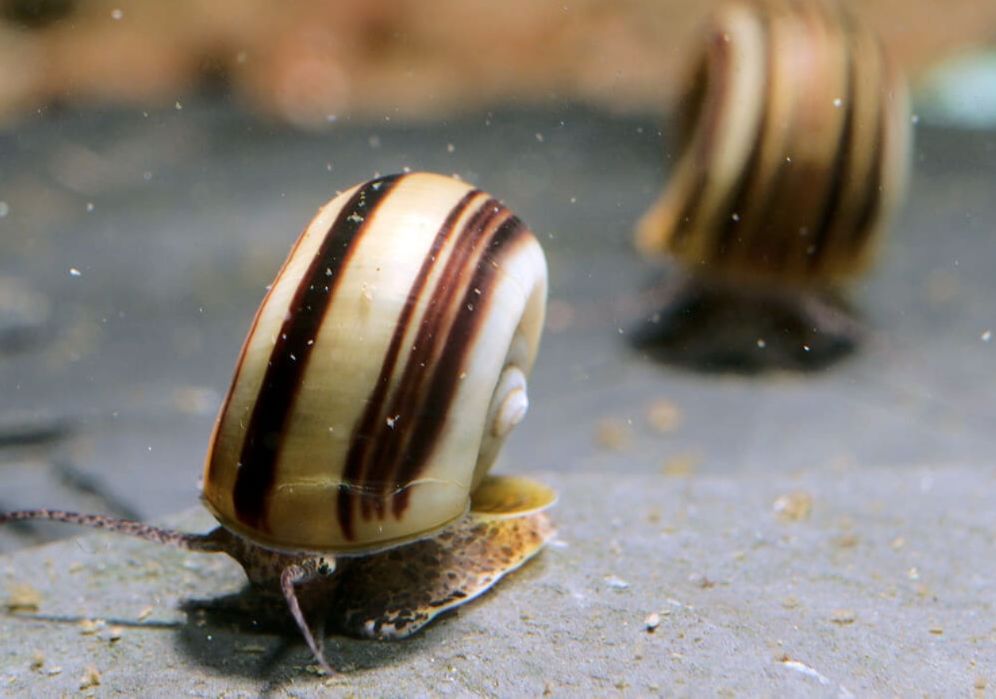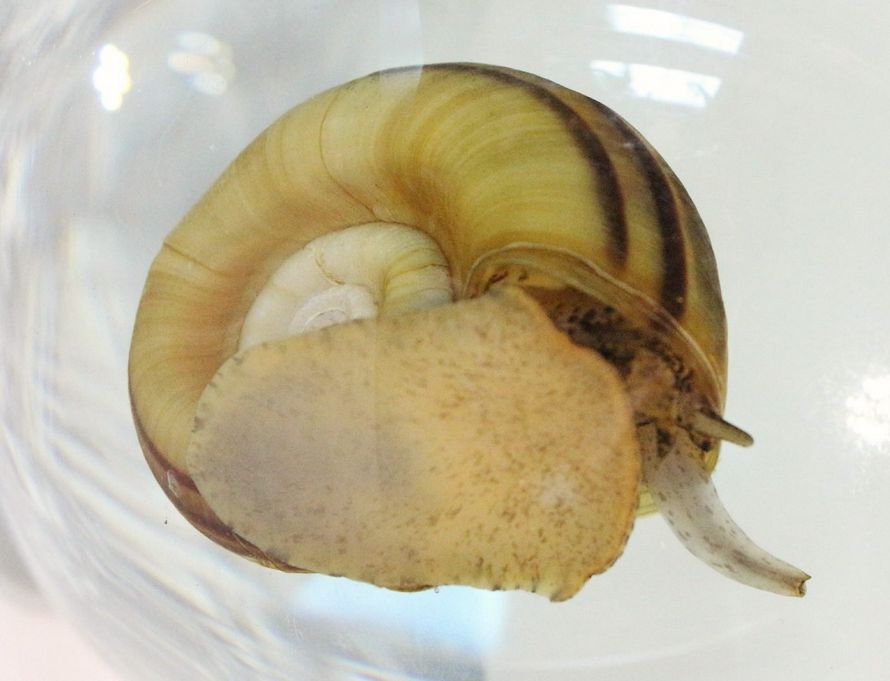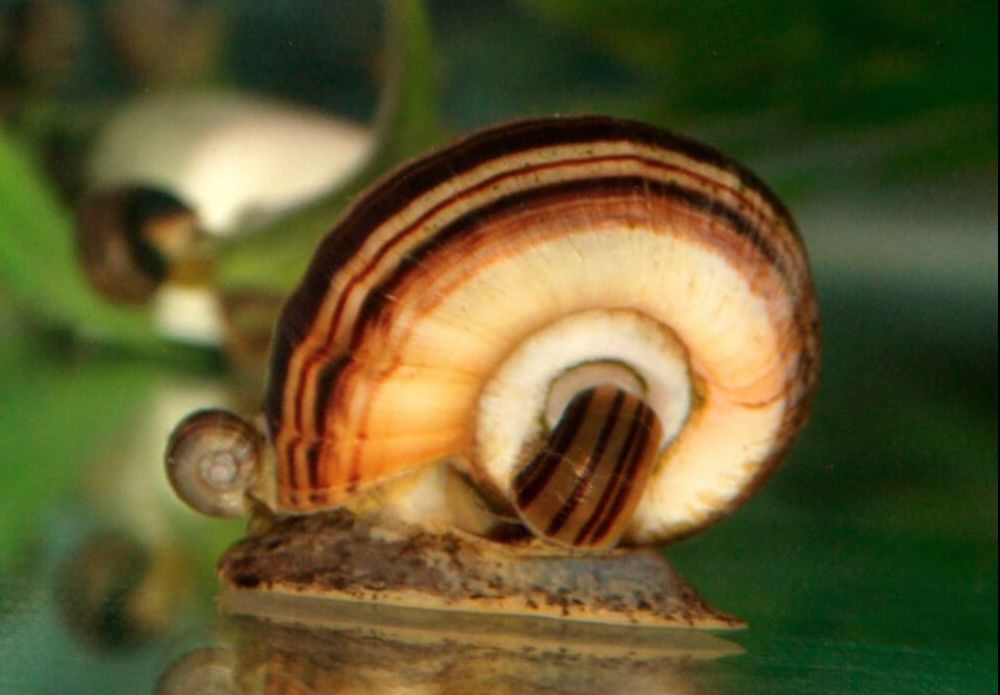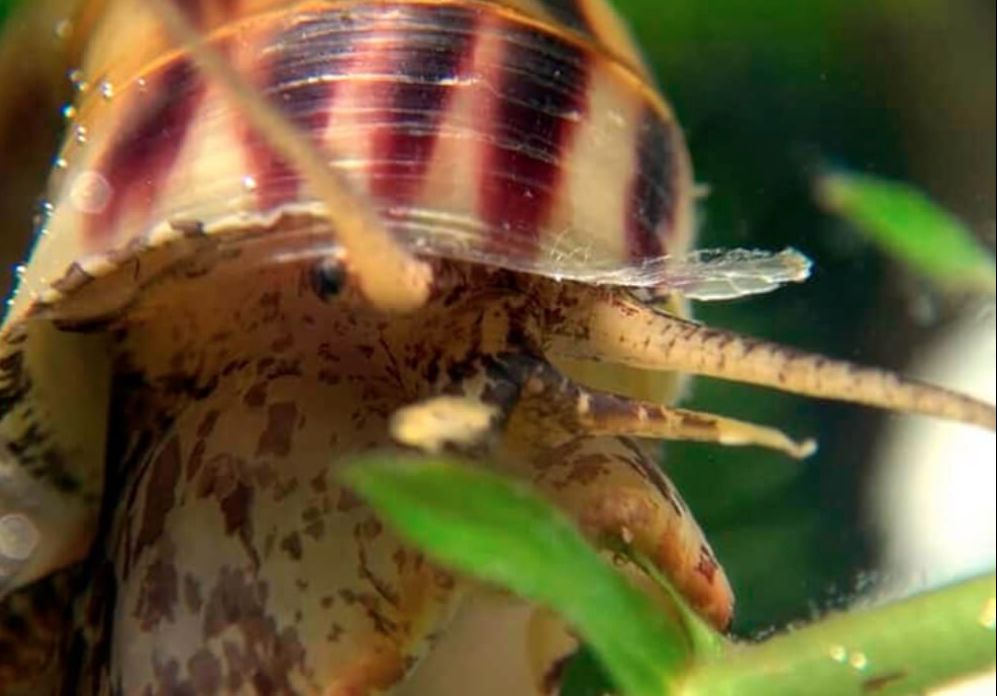The giant ramshorn snail, also known as the Colombian ramshorn snail, is a striking and popular choice among aquarium enthusiasts. These snails thrive in various freshwater environments, including lakes, rivers, and bogs, favoring calm areas with dense vegetation. While they can tolerate brackish water, breeding does not occur in such conditions. Interestingly, in several regions, giant ramshorn snails are intentionally introduced into water bodies to help control invasive plant species, as they readily consume these plants.

Contents
Habitat in the wild
The giant ramshorn snail, commonly known as the Colombian ramshorn snail, is a fascinating freshwater species belonging to the family Ampullariidae. Native to South America, it can be found in countries like Brazil, Venezuela, Panama, Honduras, and Costa Rica, where it thrives in diverse aquatic environments. Introduced to various regions due to the aquarium trade, this snail was first brought to Cuba in the late 1940s, later spreading to Puerto Rico, Florida, and Texas, adapting well to these new habitats.
Giant ramshorn snails prefer slow-moving or stagnant freshwater habitats, such as ponds, lakes, and streams, where they seek areas abundant in vegetation. They thrive in environments rich with submerged and floating plants, which provide both food and shelter. As detritivores and herbivores, they play a crucial role in aquatic ecosystems by grazing on algae and consuming detritus, dead plant matter, and decaying organic material. Their feeding habits enhance nutrient recycling, supporting the overall health of their habitats.
However, their introduction to non-native environments can lead to significant ecological challenges. When they become invasive, giant ramshorn snails can outcompete native snail species for food and resources, potentially disrupting local biodiversity. Their rapid reproduction and adaptability make them formidable invaders, which can alter the dynamics of the ecosystems they enter. In some cases, they can negatively impact local plant communities by overgrazing, further complicating their ecological footprint.
To manage their population in non-native areas, monitoring and control measures are often recommended. These snails can be kept in aquariums where their growth and breeding can be managed, helping to minimize their impact on local environments.

Description
As the name implies, the giant ramshorn snail is notable for its relatively large size compared to other snail species. Adult specimens can reach up to 2 inches (5 cm) in diameter, making them a prominent feature in any aquarium setting.
The lifespan of giant ramshorn snails can vary based on several factors, including environmental conditions, food availability, and the presence of predators. In their natural habitats, the average lifespan typically ranges from 1 to 2 years. However, with optimal care and favorable conditions in captivity, these snails can live up to 3 years or even longer in some cases.
Their shells are flat-coiled or disc-shaped, resembling a ram’s horn, which is reflected in their name. A mature giant ramshorn snail’s shell typically has about 3.5 to 4 spiral turns. The coloration of their shells is quite variable, ranging from dark yellow to deep brown, often adorned with black spiral stripes. Some mutations can occur where individuals lack stripes entirely, while others exhibit completely yellow shells. The body of the snail may be white, often featuring a yellowish, gray, or black pattern with pigment spots. Commonly, the upper surface of the body appears beige, while the underside is typically dark brown.
These snails also possess a breathing tube that is shorter than that of other members of the Ampullariidae family, such as the popular apple snail. This adaptation allows them to breathe air at the water’s surface while still maintaining their aquatic lifestyle.
| Characteristic | Description |
|---|---|
| Scientific Name | Marisa cornuarietis |
| Common Names | Giant ramshorn snail; columbian ramshorn snail, marisa snail, columbian ramshorn |
| Native Range | South America (Brazil, Bolivia, Argentina, Paraguay) |
| Size | Up to 2 inches (5 cm) in diameter |
| Shell Shape | Flat-coiled or disc-shaped, resembling a ram’s horn |
| Shell Color | Varies, often brown, red, or pink with patterns |
| Habitat | Freshwater ponds, lakes, slow-moving rivers, marshes |
| Preferred Vegetation | Abundant submerged, floating, and emergent aquatic plants |
| Diet | Omnivorous, feeding on detritus, algae, decaying plant matter |
| Reproduction | Simultaneous hermaphrodites, capable of self-fertilization |
| Reproductive Strategy | Laying eggs in gelatinous masses attached to vegetation |
| Ecological Impact | Can become invasive outside their native range |

Care and keeping in a tank
Tank Size Requirements
The tank size for giant ramshorn snails can vary based on the number of snails you plan to keep and the overall aquarium setup. As a general guideline, a minimum tank capacity of 10 gallons (38 liters) is suitable for a small group of these snails. Providing more space is always beneficial, as it contributes to the overall well-being of the snails and helps maintain stable water conditions. Regular monitoring of water parameters, along with consistent water changes and effective filtration, is crucial to maintaining optimal living conditions for giant ramshorn snails.
Water Conditions
Care for Colombian ramshorn snails can be somewhat intricate, as they require specific water parameters to thrive. Ideal conditions include moderate water hardness, a pH range of 7.5 to 7.8, and a water temperature between 21–25 °C (70–77 °F). While these snails are generally tolerant and adaptable, meeting these specific requirements is essential to ensure their health.
One interesting aspect of giant ramshorn snails is their ability to tolerate saline environments. They can survive in brackish water, with some references suggesting they can handle up to 30% salinity and a mineralization level of up to 3%. However, it’s important to note that they will not breed in such conditions.
Shell Health and pH Levels
Maintaining the right water chemistry is critical for the health of giant ramshorn snails. If the water is too soft and lacks carbonates, the integrity of their shells can be compromised, leading to deterioration. Additionally, water with a low pH level can create an uncomfortable environment for these snails, making it imperative to monitor and adjust the pH as necessary.
Adaptability in Habitat
While the size of the tank is not the most critical factor for giant ramshorn snails, they can be kept in both open and closed systems. Although they are not overly demanding regarding water temperature, it’s advisable to maintain a temperature range of 75–81 °F (24–27 °C) for optimal health. It’s worth noting that giant ramshorn snails are sensitive to sudden drops in water and air temperature, so stable conditions are vital for their well-being.
Breeding
Reproductive Characteristics
Giant ramshorn snails are hermaphroditic, meaning each individual possesses both male and female reproductive organs. Notably, females can be identified by the dark chocolate coloring of their bodies, while males typically display a light beige coloration with barely noticeable brownish spots. This sexual dimorphism can assist aquarists in recognizing the genders, although both sexes contribute to the reproductive process.
Egg-Laying Behavior
These snails exhibit unique egg-laying behavior by depositing their eggs on the underside of leaves, typically above the waterline. The eggs are laid in clusters or masses, which appear translucent and gelatinous. Each egg mass can resemble small, clear spheres that are stuck together, with individual eggs measuring about 2–3 mm in size. This positioning above the water helps protect the eggs from potential flooding and increases their chances of survival.
Egg Mass Composition
The number of eggs within a single mass can vary widely, ranging from a few dozen to several hundred. This variability depends on factors such as the size and reproductive capacity of the adult snails. The ability to lay large quantities of eggs is a significant factor in their population growth and resilience in various environments.
Incubation and Hatching
After laying their eggs, the incubation period typically lasts around 2 to 4 weeks, depending on environmental conditions such as temperature and humidity. As the eggs develop, they transition from translucent to opaque, and their color may darken. When the young snails are ready to emerge, they can often be seen dispersing throughout the tank. However, it’s important to note that not all juveniles will survive due to various environmental challenges and predation pressures.
Juvenile Survival
Once hatched, the small snails must quickly adapt to their surroundings as they begin their independent lives. Factors such as water quality, available food, and tank mates play critical roles in determining the survival rate of juvenile giant ramshorn snails. Although they are generally resilient, the survival rate can vary significantly, highlighting the importance of providing a stable and nurturing environment.

Feeding
In their natural habitats, Colombian ramshorn snails are primarily herbivorous, feeding on a variety of plant materials. They thrive on different types of vegetation, which provides them with essential nutrients. This plant-based diet contributes to their health and well-being in the wild.
Omnivorous Behavior in Aquariums
In aquariums, giant ramshorn snails exhibit omnivorous feeding behavior. They will consume a wide range of food types, including live, frozen, and artificial feeds. While this adaptability allows them to thrive in various conditions, it can also pose challenges for aquarists. When hungry, these snails may turn their attention to aquarium plants, often causing significant damage as they graze. Their feeding habits can resemble that of a lawn mower, making it advisable to keep them in tanks with limited or no plants if preservation of aquatic vegetation is a priority.
Recommended Diet
To ensure a well-balanced diet for giant ramshorn snails, it’s essential to complement their feeding regimen with fresh vegetables. Options like cucumbers, squash, and cabbage are excellent choices that provide necessary nutrients. Additionally, including specially formulated tablets for catfish can enhance their diet. Commercially available snail food, such as sinking pellets or flakes designed specifically for herbivorous snails, can also be offered to ensure they receive adequate nutrition.
Feeding Strategies
To minimize damage to tank plants while still supporting the snails’ dietary needs, consider establishing a dedicated feeding routine. Offering food in designated areas can help keep snails from wandering into plants. Regularly providing fresh vegetables and high-quality snail food will help satisfy their hunger, promoting healthy growth and reducing the likelihood of them munching on tank flora.
Tank mates
As for these large snails compatibility with other tank inhabitants – there are no reasons to be worried. They are peaceful creatures, which will successfully coexist with the same peaceful fishes. Many peaceful community fish species can be suitable tankmates for Colombian ramshorn snails. Examples include tetras (such as neon tetras or cardinal tetras), rasboras, guppies, mollies, swordtails, and dwarf gouramis. Make sure the fish species you choose are not aggressive or prone to nipping at snails.